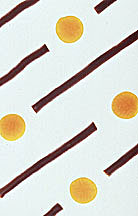Fruitful Research Leads to Nutritious Sweets
 Molded and extruded fruit purees can enhance the nutritional quality of candies, baked goods, and frozen treats. (K7493-1) |
Satisfying both your sweet tooth and your nutritional goals could soon be easier than ever. That’s because ARS scientists have developed a way to add more fruit to confections, baked goods, and frozen treats.
“Many candies and baking ingredients already include some fruit, but they often contain mostly sugar. By creating products with fruit as the main ingredient, consumers can get a more nutritious end product,” says ARS research food technologist Tara H. McHugh.
Fruit growers could also benefit from an expanded market for fruits like peaches, pears, and apricots, she says. And the fresh fruit could be pureed during the growing season and then processed year-round.
McHugh and colleagues combine fruit puree with unique gelling agents and then form the mixture into shapes using molds or twin-screw extruders. So far, they’ve included up to 30 percent fruit in the molded pieces, with moisture, starch, and sugar making up the other ingredients. With the extrusion process, the product can be made entirely of fruit puree.
Agricultural engineer Charles C. Huxsoll and technicians Julie Hsu and Joseph Carlos also work on the project. All are in the ARS Process Chemistry and Engineering Unit at the Western Regional Research Center in Albany, California.
"Restructuring fruit by using gelling agents with twin-screw extrusion is new, and it may take the industry process to a new level of sophistication," says Huxsoll. The gelling agents, which include new combinations of starch and gelatin, make the texture of the fruit mixture adaptable to a wide variety of uses.
Depending on the ingredients used with the puree, textures could range from soft and chewy to hard and crunchy.
The puree mixture can be poured into molds to make virtually any shape. The twin-screw extruder combines the ingredients and pushes the mixture through a die. The long rope of fruit product is then cut into pieces such as stars, squares, or circles, depending on the shape of the die.
"Restructured fruit pieces that would be developed by confectioners into candy alternatives would require different functional properties than pieces to be incorporated into baked or frozen foods. By using different gelling agents, the properties can be developed to meet the needs of these varied applications," says McHugh.
One potential limiting factor to molding the puree mixture is its viscosity.
"If the viscosity of the fruit mixture is too high, it won't flow smoothly into the mold. The resulting pieces would be irregularly shaped and less appealing to consumers,” says McHugh.
The extrusion process overcomes this limitation, because the mixture is blended and shaped within the extruder and doesn't require pouring. It's also faster, taking only minutes to produce the final product. Molded pieces may take about 1 day to set.
Researchers are ready to move the technology from the lab to commercial applications. The confectionery, or candy, industry would likely be the first and largest user. -- By Kathryn Barry Stelljes, ARS
Tara H. McHugh is in USDA-ARS Process Chemistry and Engineering Research Unit, Western Regional Research Center, 800 Buchanan St., Albany, CA 94710; phone (510) 559-5864.
"Fruitful Research Leads to Nutritious Sweets" was published in the November 1996 issue of Agricultural Research magazine.






